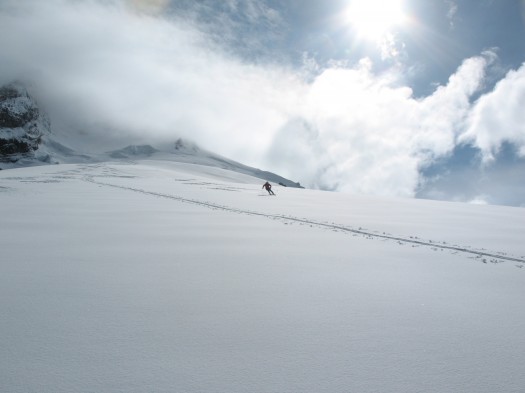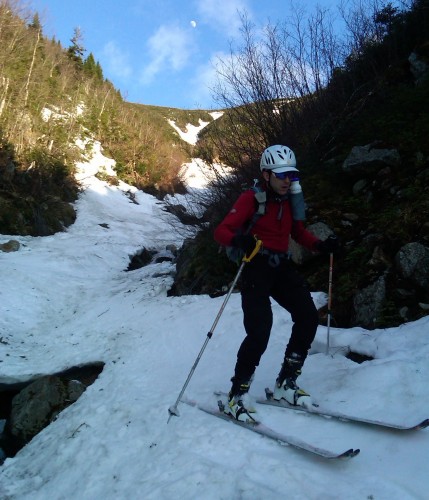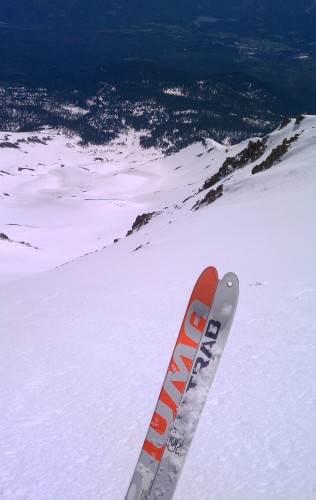Is this retro day at WildSnow.com? Or have rando-racer-types infiltrated the blog? What’s next, reviews of tights for ski mountaineering and advice on how to starve yourself so you can trim 10 grams of mass from your cuerpo? We shall see. Meanwhile, check out some of the lighter weight planks on the market.
Seriously though, although such skis are frequently scoffed at and classified as tools useful only for skiing tight steep lines or slogging herculean traverses, I think ultralight skis with waist widths in the 70s are perfect for the typically consolidated snow conditions of late spring and early summer backcountry skiing and ski mountaineering.
A quiver of one? Hardly. But then again, if you’re the kind of skier who would be satisfied with a single setup, then you’re probably not reading WildSnow.com blog posts in August, anyway.

I thought we were going to ski perfect corn? Okay, fine I'll settle for untracked powder instead. (Mt Hood's Snowdome Glacier- May 26, 2008)
For this category of skis, obviously you can forget about rocker or even any early tip rise. My criteria were that the waist width had to be over 70mm, otherwise the ski is firmly in rando race territory, which is great if you expect consolidated snow conditions and only consolidated snow conditions, but anything unconsolidated and those few extra mm make a big enough difference in a non-race setting to justify their extra mass (relatively speaking) on the up.
Speaking of readily available, that attribute has a broader range than pretty much any other element in the table for those outside Europe. Some of the models here are from companies with strong presences in the North American alpine downhill market (Atomic, Blizzard, Dynastar, Elan) yet do not distribute their lightweight ski mountaineering models here. (Shame on them!) At the other extreme are some companies whose only attribute of which I am certain is that I didn’t make them up (Differences, Lighter Ski).
Newcomers to this segment include La Sportiva (new to skiing entirely) and G3. Traditionally backcountry-oriented ski companies include BD, Dynafit, Hagan, Movement, and Trab. Dynafit is a bit of a newcomer as their two prior iterations of a 70s-waisted ski had almost no distribution in North America. But the Broad Peak is carried by a surprisingly large number of shops, and has been used in an unsurprisingly large number of impressively long (yet fast!) trip reports on various blogs this past season.
Movement has four different models in the table. But its North American distributor last year had very limited availability. For this coming season, La Sportiva North America will take over distribution, but its focus will be on the Movement models appealing to alpine downhill shops (while La Sportiva’s own models — all tightly focused on backcountry skiing and ski mountaineering — go to backcountry shops). Since I have their Fish-X rando racer and their 80s-ish Logic-X, I’m disappointed that the Random-X will not be available.
Trab picks up much stronger distribution this season from Scarpa, and the Duo Free Rando Light will be available. I’m disappointed though that the Duo Sint Aero will not be available. Over the course of five seasons of late spring and early summer skiing, I’ve used them in all sorts of snow conditions (and even, umm, non-snow conditions). They ski perfectly in nice corn of course, and hold an edge perfectly on unripened corn and ski area “firm” groomer training sessions. When the corn is overly ripe, or fresh powder is unexpectedly encountered, a wider ski would of course be optimal, but the narrower ski still performs surprisingly well.
Their durability has also been a welcome surprise, even at over 100 outings and nearly half a million vertical feet. When I tapped the mounting holes the first time, I was a bit alarmed at how effortlessly the tap went in, then showed no apparent signs of bottoming out. Subsequently while playing around with binding toe shims, and also when remounting the heels for the diminutive DyNA/TLT5 sole length, I’ve removed and reinstalled the toe screws several times. Yet never a single spinner.
All specs in the table below are as published, including weights for a length somewhere in the 160s. The weight cut-off I set at that of the Dynafit Mustagh Ata Superlight, since I didn’t see much point in any 70s-waisted ski that weighs more than a 86mm to 88mm model (depending on length) that is reasonably priced and readily available.
The table’s “d” is for sidecut depth, which I calculated using the standard formula of tip plus tail minus twice waist (i.e., the bigger the “d” number, the turnier the ski). The “r” is for turning radius (i.e., the smaller the “r” number, the turnier the ski), as stated (or sometimes not) by the manufacturer, which is a function of both sidecut depth and contact length. (Note that a ski can’t have a constant set of sidecut specs and turning radius throughout all the lengths — some models vary the sidecut, some vary the turning radius, and some even both.)
****************************************
| WildSnow chart: Ultralight Skinny Skis for Spring & Summer Ski Mountaineering. Waist width greater than 70mm (otherwise in rando race ski territory), and weight less than Dynafit Mustagh Ata Superlight. | |||||||||||
| Company | Model | cm | lb | oz | g | Sidecut | d | r — | msrp | ||
| Atomic | Guide Huberbuam | 164 | 5 | 4.0 | 2380 | 107 | 72 | 96 | 59 | 18.0 | € 319 |
| B.D. | Guru | 167 | 5 | 4.3 | 2390 | 120 | 75 | 105 | 75 | 15.0 | $540 |
| Blizzard | TA Expedition | 168 | 5 | 1.8 | 2320 | 112 | 74 | 96 | 60 | 17.5 | |
| Differences | Tour Light | 166 | 4 | 7.6 | 2030 | 114 | 72 | 100 | 70 | 14.0 | € 800 |
| Dynafit | Broad Peak | 167 | 4 | 11.8 | 2150 | 112 | 74 | 96 | 60 | 17.5 | $650 |
| Haute Route Plus | 163 | 5 | 1.8 | 2320 | 113 | 78 | 100 | 57 | 18.8 | $600 | |
| Nanga Parbat | 167 | 5 | 1.8 | 2320 | 102 | 73 | 89 | 45 | 24.7 | € 475 | |
| Se7en Summits Superlight | 163 | 5 | 3.2 | 2359 | 113 | 78 | 100 | 57 | 18.8 | $630 | |
| Dynastar | Altitrail Vertical Light | 160 | 4 | 12.2 | 2160 | 103 | 75 | 92 | 45 | 20.0 | € 329 |
| G3 | 78 Stinger | 166 | 5 | 4.7 | 2400 | 112 | 78 | 100 | 56 | $570 | |
| Hagan | Spirit | 163 | 5 | 6.1 | 2440 | 112 | 73 | 100 | 66 | 14.9 | $430 |
| X-Ultra | 163 | 4 | 6.5 | 2000 | 111 | 71 | 101 | 70 | 14.7 | $630 | |
| Elan | Aconcagua | 165 | 104 | 72 | 91 | 51 | 20.4 | ||||
| Elbrus | 165 | 5 | 4.6 | 2397 | 104 | 72 | 91 | 51 | 20.4 | € 270 | |
| Makalu | 165 | 104 | 72 | 91 | 51 | 20.4 | |||||
| La Sportiva | RST | 167 | 4 | 13.6 | 2200 | 116 | 77 | 106 | 68 | 17.0 | $579 |
| Lighter Ski | Spatzle | 171 | 3 | 14.8 | 1780 | 115 | 76 | 105 | 68 | 18.5 | € 700 |
| Movement | Feather | 167 | 5 | 1.1 | 2300 | 115 | 76 | 105 | 68 | 19.0 | € 485 |
| Random | 167 | 4 | 13.6 | 2200 | 115 | 76 | 105 | 68 | 19.0 | € 528 | |
| Random X-Series | 167 | 4 | 1.6 | 1860 | 115 | 76 | 105 | 68 | 19.0 | € 739 | |
| Red Apple 74 | 168 | 5 | 4.7 | 2400 | 114 | 74 | 103 | 69 | 18.0 | € 449 | |
| Trab | Duo FreeRando Light | 164 | 5 | 0.4 | 2280 | 112 | 79 | 96 | 50 | 22.0 | $779 |
| Duo Sint Aero | 164 | 4 | 4.1 | 1930 | 105 | 73 | 89 | 48 | 24.0 | € 700 | |
| Duo Sintesi | 164 | 5 | 1.1 | 2300 | 105 | 73 | 89 | 48 | 24.0 | € 410 | |

I can't believe how well these Trab skis have held up after five years of use and abuse. (NH's Monroe Brook, with the late-season emphasis on brook, wrapping up a nearly 10,000 multiple-ravine circumnavigation of Mt Washington- May 13, 2011)
If anyone has any ideas for other offerings we can add to the list of skis in the table above, please comment and we’ll try to add them in.
(WildSnow guest blogger Jonathan Shefftz lives with his wife and daughter in Western Massachusetts, where he is a member of the Northfield Mountain and Thunderbolt / Mt Greylock ski patrols. Formerly an NCAA alpine race coach, he has broken free from his prior dependence on mechanized ascension to become far more enamored of self-propelled forms of skiing. He is an AIARE-qualified instructor, NSP avalanche instructor, and contributor to the American Avalanche Association’s The Avalanche Review. When he is not searching out elusive freshies in Southern New England or promoting the NE Rando Race Series, he works as a financial economics consultant.)
WildSnow guest blogger Jonathan Shefftz lives with his wife and daughter in Western Massachusetts, where he is a member of the Northfield Mountain and Thunderbolt (Mt. Greylock) ski patrols. Formerly an NCAA alpine race coach, he has broken free from his prior dependence on mechanized ascension to become far more enamored of self-propelled forms of skiing. He is an AIARE-qualified instructor, NSP avalanche safety instructor, and contributor to the American Avalanche Association’s The Avalanche Review. When he is not searching out elusive freshies in Southern New England, he works as a financial economics consultant.

